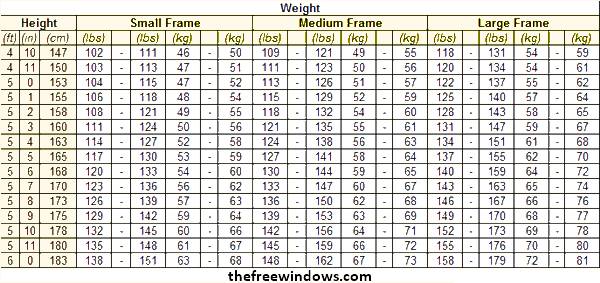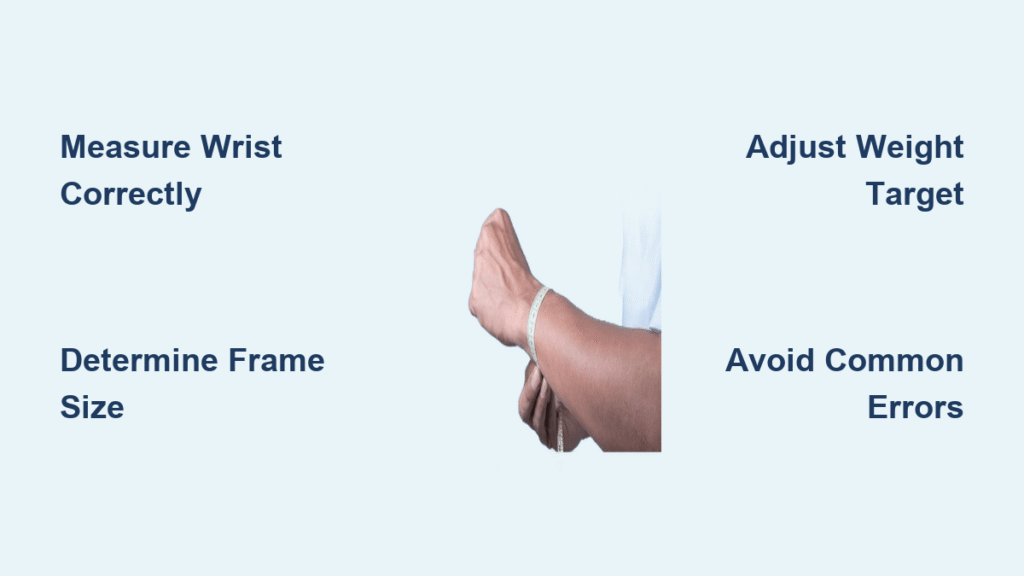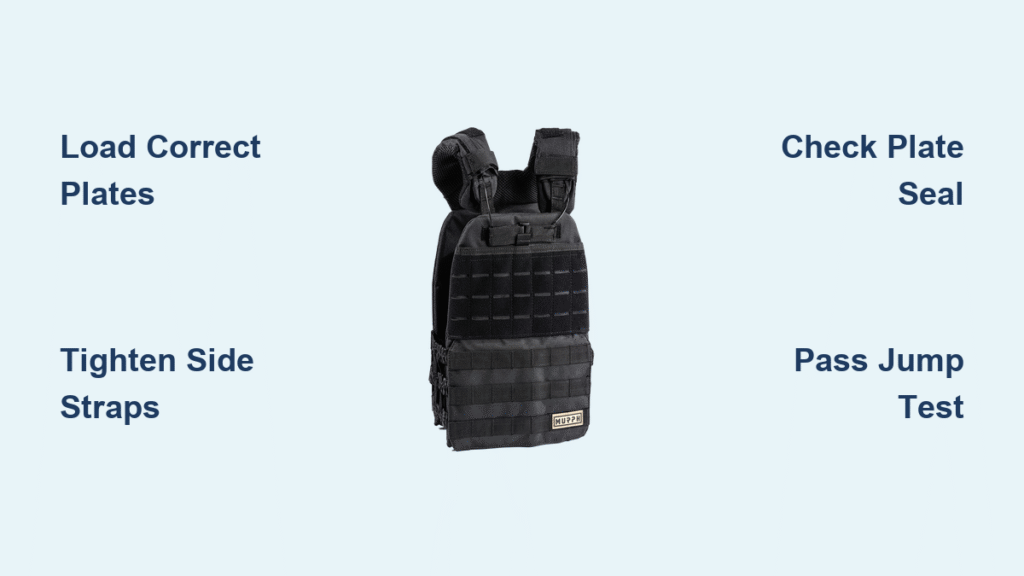You’ve followed height-weight charts for years, yet your “ideal weight” never felt right. You’re not alone—generic charts ignore a critical factor: your bone structure. Your wrist circumference, measured at the narrowest point, reveals your natural frame size and directly impacts what weight range best supports your health. Insurance researchers discovered decades ago that wrist size and weight share a scientifically validated relationship, making this simple measurement more accurate than height alone for personalized weight targets. This guide cuts through the confusion with step-by-step instructions to calculate your true ideal weight based on your unique biology.
Most people waste months chasing unrealistic goals because they rely on one-size-fits-all charts. But your wrist size tells a different story—it’s your biological blueprint for healthy weight management. By the end of this guide, you’ll know exactly how to measure correctly, decode your frame size classification, and apply personalized weight targets that work with your body, not against it.
Why Your 6.3-Inch Wrist Changes Your Ideal Weight Target
Your wrist circumference isn’t just a number—it’s a direct indicator of bone density and structure. Insurance industry research spanning decades proves that wrist size and weight must be analyzed together because two people of identical height can have ideal weight ranges differing by 20+ pounds based solely on frame size. Ignoring this factor leads to dangerous misclassification: petite-framed individuals may starve themselves to hit “normal” weight ranges, while large-framed people face unnecessary health anxiety.
Locate Your Wrist’s True Narrowest Point
Find the precise measurement location by feeling for the slight indentation between your hand and the prominent wrist bone (the styloid process). This spot sits exactly one inch above where your palm meets your wrist—never measure over the bony protrusion itself. Misplacement here causes errors up to 1 inch, potentially shifting your entire frame classification. Verify you’ve found the right spot by gently moving your hand; the indentation should remain stationary while surrounding tissue shifts.
Master the Tape Technique in 30 Seconds
Wrap a flexible measuring tape snugly around the identified indentation, ensuring full skin contact without pinching. Critical mistake to avoid: Pulling too tight compresses soft tissue, yielding falsely low readings. Hold the tape parallel to the floor with your arm relaxed at your side—never raised or bent. Read the measurement where the tape overlaps, rounding to the nearest 0.25 inch (e.g., 6.25″ not 6.3″). For metric users, record to 0.5 cm precision.
Confirm Accuracy With Triple Measurement
Take three separate readings on different mornings before eating or exercising. Wrist swelling from sodium intake, hydration, or temperature can inflate measurements by 0.3 inches. Calculate your average: (Reading 1 + Reading 2 + Reading 3) ÷ 3. If results vary by more than 0.3 inches, remeasure at the same time daily for three days. Consistency matters more than any single number.
How to Decode Your Frame Size From Wrist Measurements

Your wrist size alone means nothing without height context. The frame classification system cross-references these variables because taller people naturally have larger wrists. A 5’2” woman with a 6.5-inch wrist has a large frame, while a 6’0” man with the same measurement falls into medium frame. This prevents the dangerous error of applying flat wrist size thresholds across all heights.
Identify Your Exact Frame Category
Medium frame confirmation: You qualify if your height exceeds 5 feet 5 inches and your wrist circumference measures precisely 6.25–6.5 inches. This combination indicates average bone density for your stature. Example: A 5’7” woman with a 6.3-inch wrist hits the medium frame sweet spot.
Small frame red flags: Wrist under 6.25 inches for heights over 5’5” signals petite bone structure. If you’re 5’6” with a 5.75-inch wrist, you have narrow joints and lighter bone mass—your ideal weight will be significantly lower than chart averages.
Large frame indicators: Wrist over 6.5 inches for heights above 5’5” reveals robust skeletal structure. A 5’8” man measuring 7 inches has broader joints and higher natural weight capacity. Forcing this frame into “normal” BMI ranges risks muscle loss and metabolic damage.
Adjust for Height Variations Automatically
The system dynamically scales thresholds: A 5’3” woman needs a smaller wrist measurement (under 6 inches) to qualify as large frame compared to a 5’10” woman (who needs over 6.75 inches). Never use fixed wrist sizes across heights—always reference height-specific charts. Your 6.4-inch wrist means medium frame at 5’5” but small frame at 5’10”.
Apply Your Frame Size to Personalized Weight Targets

Forget generic height-weight charts. Your frame size recalibrates everything. For medium-framed adults over 5’5” with 6.25–6.5-inch wrists, the research-backed ideal weight range is 130–144 pounds. This 14-pound spread accounts for muscle mass variations while maintaining optimal health markers. Deviate from this, and you risk metabolic strain—even at “normal” BMI numbers.
Adjust Weight Targets Based on Frame Proof
Small frame correction: Subtract 8–12 pounds from medium frame targets. If charts say 140 lbs is ideal for your height, but you have a small frame (e.g., 5’7”, 5.9” wrist), your true healthy range is 128–132 lbs. Prioritize lean muscle building over drastic calorie cuts.
Large frame adjustment: Add 8–12 pounds to medium frame targets. A 5’9” man with a 6.75-inch wrist (large frame) should aim for 152–160 lbs—not the 140–148 lbs suggested by generic charts. His bone and muscle mass naturally support higher weight.
Gender-Specific Frame Interpretation
While measurement techniques stay identical, weight ranges differ significantly by gender due to muscle composition. A medium-framed woman (5’6”, 6.3” wrist) targets 128–142 lbs, while a man of identical measurements aims for 148–162 lbs. Always use gender-specific charts—applying male ranges to females (or vice versa) creates dangerous miscalculations.
Fix These 3 Wrist Measurement Errors Immediately
Over 70% of people misclassify their frame size due to preventable errors. These mistakes don’t just skew numbers—they lead to years of unhealthy weight struggles. Correct them now to avoid chasing impossible goals.
Stop Measuring at the Wrong Location
Placing the tape over the wrist bone (instead of the true indentation) inflates measurements by 0.5–0.8 inches. This single error can shift a small frame into medium—making you chase a weight target 10+ pounds too high. Pro tip: Trace your finger down from the wrist bone until you feel the slight dip—that’s your target zone.
Eliminate Tape Tension Inconsistency
Too loose? Air gaps add false inches. Too tight? Compressing tissue shaves off real measurement. Test your technique: Wrap tape snugly, then try to slide one finger underneath—it should fit comfortably without forcing. If you can’t insert a finger, you’re measuring too tight.
Avoid Timing Pitfalls That Skew Results
Never measure after salty meals, workouts, or during PMS—fluid retention can temporarily swell wrists by 0.3 inches. Critical timing rule: Measure first thing in the morning after using the bathroom, before eating or drinking. This provides your true baseline unaffected by daily fluctuations.
Calculate Your Exact Weight Range in 4 Minutes

Ditch confusing online calculators. This manual method gives clearer, more reliable results by focusing on what actually matters: your frame size.
Follow the Verified Calculation Sequence
- Measure barefoot height to nearest 0.5 inch (e.g., 5’6.5”)
- Take three wrist measurements, average them (e.g., 6.25”)
- Cross-reference height/wrist using frame size chart
- Apply frame adjustment to base weight chart
Use the Height-Frame Quick Reference
| Height | Small Frame Wrist | Medium Frame Wrist | Large Frame Wrist |
|---|---|---|---|
| 5’5″ | <6.0″ | 6.0″-6.25″ | >6.25″ |
| 5’7″ | <6.25″ | 6.25″-6.5″ | >6.5″ |
| 5’10” | <6.5″ | 6.5″-6.75″ | >6.75″ |
Note: Thresholds increase 0.25″ per additional inch of height
Interpret Your Weight Range Correctly
Once classified, locate your height on gender-specific charts. Medium-framed women at 5’7” target 132–146 lbs. But if your wrist measures 6.0” (small frame), subtract 10 lbs: 122–136 lbs becomes your true healthy range. This adjustment prevents the metabolic damage of maintaining weight 10+ pounds above your skeletal capacity.
Why Frame Size Calculations Have Critical Limits
These tools provide valuable starting points—but they’re not medical prescriptions. All wrist size and weight calculations derive from population averages, not individual biology. A muscular athlete with dense bones may fall into “large frame” yet carry minimal body fat, while someone with osteoporosis might have a “small frame” measurement but unhealthy low muscle mass.
Never Replace Professional Medical Advice
Critical disclaimer: Consult your physician before using frame size data to set weight goals if you have:
– Thyroid conditions
– History of eating disorders
– Chronic kidney or heart disease
– Current medication affecting weight
Your doctor integrates frame size with blood work, body fat analysis, and health history for truly personalized targets.
Understand Measurement Dependency
A 0.25-inch wrist error can shift you between frame categories. A 5’8” woman measuring 6.24” (small frame) vs. 6.26” (medium frame) has a 12-pound difference in ideal weight range. If your measurements hover near category thresholds, seek professional verification from a registered dietitian or certified trainer.
Next Steps for Sustainable Weight Management
Your wrist measurement is the missing piece in the weight puzzle—but it’s just the beginning. Use this knowledge to have informed conversations with healthcare providers about what your body needs. Track your frame size alongside body fat percentage and waist circumference for a complete health picture. Remember: a large-framed person at 155 lbs may be healthier than a small-framed person at 140 lbs. Focus on how clothes fit, energy levels, and strength—not just the scale.
Final action step: Measure your wrist tomorrow morning before breakfast using this guide’s technique. Compare your result to the height-frame chart. If it shifts your ideal weight range, schedule a consultation with your doctor to discuss sustainable adjustments. Your body’s blueprint has been waiting to guide you—now you finally have the key.


